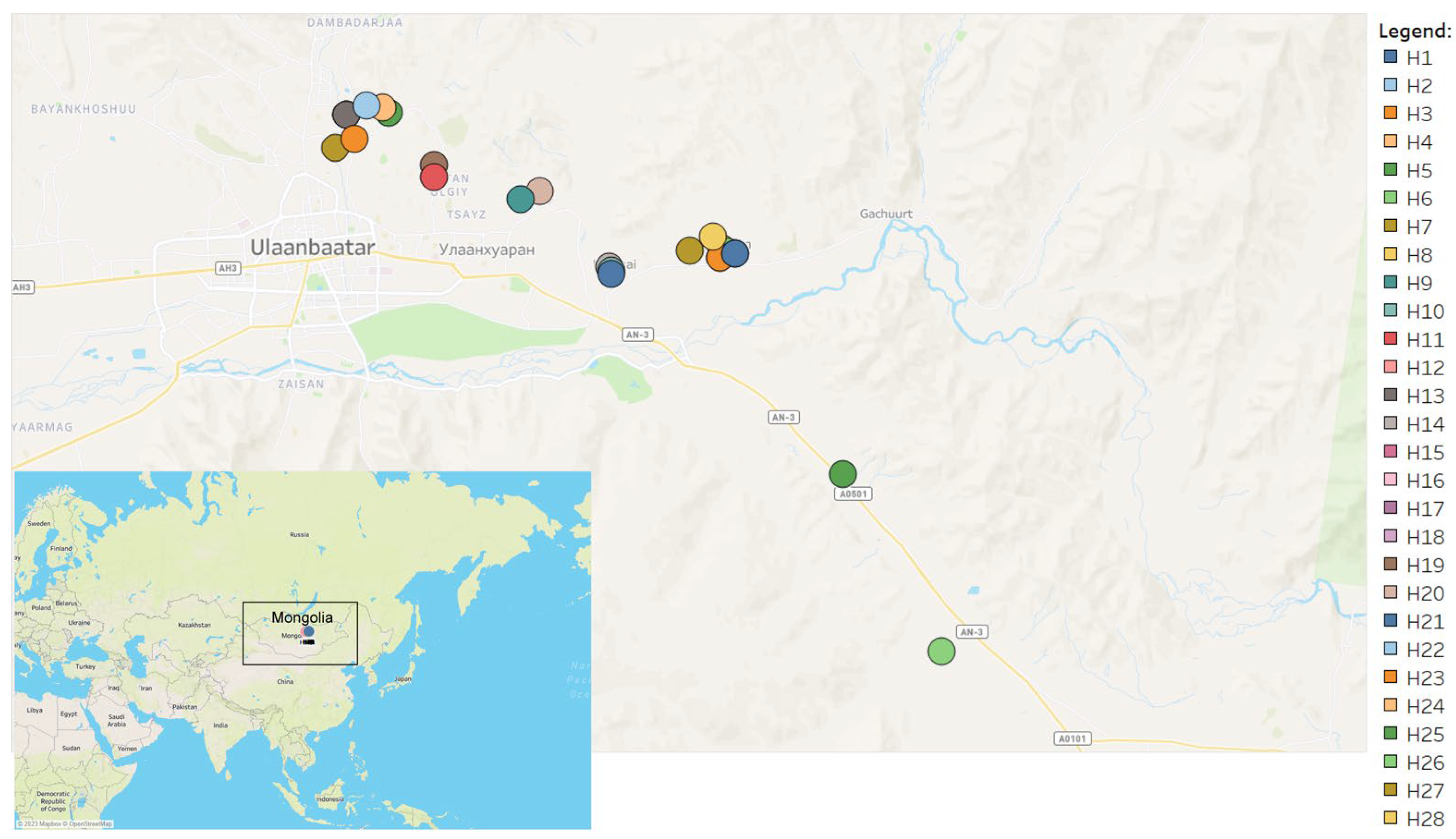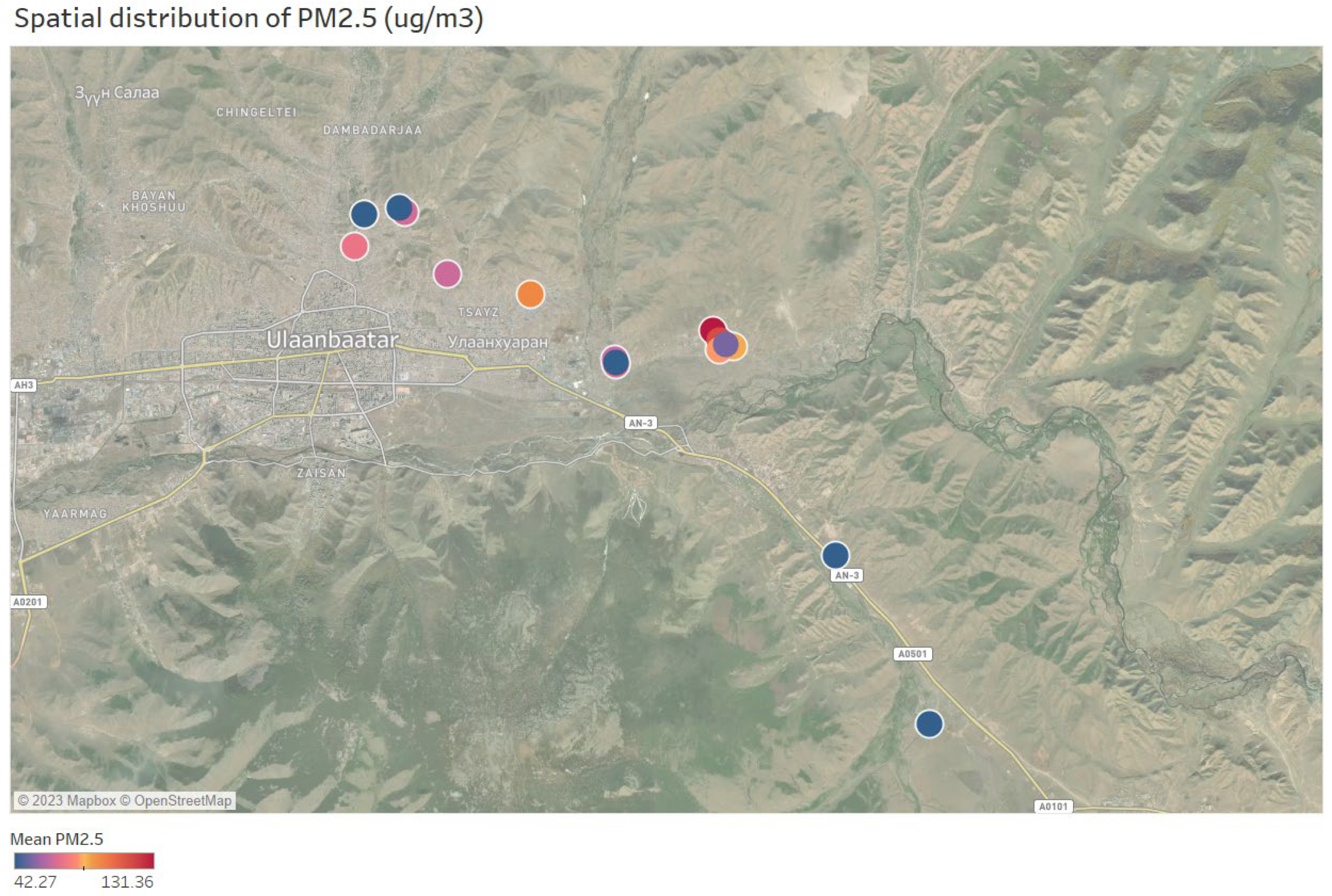Addressing Air Pollution in Ulaanbaatar and Evaluating Indoor Air Quality in Gers with Cooking, Heating, and Insulation Packages (CHIP) †
Abstract
:1. Introduction
2. Methods
3. Results
4. Discussion and Conclusions
Author Contributions
Funding
Informed Consent Statement
Data Availability Statement
Acknowledgments
Conflicts of Interest
References
- Cousins, S. Air pollution in Mongolia. World Health Organization. Bull. World Health Organ. 2019, 97, 79–80. [Google Scholar] [CrossRef]
- Davy, P.K.; Gunchin, G.; Markwitz, A.; Trompetter, W.J.; Barry, B.J.; Shagjjamba, D.; Lodoysamba, S. Air particulate matter pollution in Ulaanbaatar, Mongolia: Determination of composition, source contributions and source locations. Atmos. Pollut. Res. 2011, 2, 126–137. [Google Scholar] [CrossRef]
- Guttikunda, S.K.; Lodoysamba, S.; Bulgansaikhan, B.; Dashdondog, B. Particulate pollution in Ulaanbaatar, Mongolia. Air Qual. Atmos. Health 2013, 6, 589–601. [Google Scholar] [CrossRef]
- Hasenkopf, C.A.; Veghte, D.P.; Schill, G.P.; Lodoysamba, S.; Freedman, M.A.; Tolbert, M.A. Ice nucleation, shape, and composition of aerosol particles in one of the most polluted cities in the world: Ulaanbaatar, Mongolia. Atmos. Environ. 2016, 139, 222–229. [Google Scholar] [CrossRef]
- Allen, R.W.; Gombojav, E.; Barkhasragchaa, B.; Byambaa, T.; Lkhasuren, O.; Amram, O.; Takaro, T.K.; Janes, C.R. An as-sessment of air pollution and its attributable mortality in Ulaanbaatar, Mongolia. Air Qual. Atmos. Health 2013, 6, 137–150. [Google Scholar] [CrossRef] [PubMed]
- Byambaa, B.; Yang, L.; Matsuki, A.; Nagato, E.G.; Gankhuyag, K.; Chuluunpurev, B.; Banzragch, L.; Chonokhuu, S.; Tang, N.; Hayakawa, K. Sources and characteristics of polycyclic aromatic hydrocarbons in ambient total suspended particles in Ulaanbaatar City, Mongolia. Int. J. Environ. Res. Public Health 2019, 16, 442. [Google Scholar] [CrossRef] [PubMed]
- Nirmalkar, J.; Batmunkh, T.; Jung, J. An optimized tracer-based approach for estimating organic carbon emissions from biomass burning in Ulaanbaatar, Mongolia. Atmos. Chem. Phys. 2020, 20, 3231–3247. [Google Scholar] [CrossRef]
- Nishikawa, M.; Matsui, I.; Batdorj, D.; Jugder, D.; Mori, I.; Shimizu, A.; Sugimoto, N.; Takahashi, K. Chemical composition of urban airborne particulate matter in Ulaanbaatar. Atmos. Environ. 2011, 45, 5710–5715. [Google Scholar] [CrossRef]
- Batmunkh, T.; Kim, Y.J.; Jung, J.S.; Park, K.; Tumendemberel, B. Chemical characteristics of fine particulate matters measured during severe winter haze events in Ulaanbaatar, Mongolia. J. Air Waste Manag. Assoc. 2013, 63, 659–670. [Google Scholar] [CrossRef] [PubMed]
- Amgalan, N.; Narantsetseg, T.; Shagjjamva, D. Valuations of elemental concentrations of particle matter in Ulaanbaatar, Mongolia. Open J. Air Pollut. 2016, 5, 160–169. [Google Scholar] [CrossRef]
- Ganbat, G.; Han, J.Y.; Ryu, Y.H.; Baik, J.J. Characteristics of the urban heat island in a highaltitude metropolitan city, Ulaanbaatar, Mongolia. Asia Pac. J. Atmos. Sci. 2013, 49, 535–541. [Google Scholar] [CrossRef]
- Ganbat, G.; Baik, J.J. Wintertime winds in and around the Ulaanbaatar metropolitan area in the presence of a temperature inversion. Asia Pac. J. Atmos. Sci. 2016, 52, 309–325. [Google Scholar] [CrossRef]
- Dagvadorj, A.; Ilie, A.M.C.; Byambadorj, E.; Tsogtsaikhan, A.; Let’s Take Action! Breathe Mongolia’s Air Pollution Reduction Project now Underway. Breathe Mongolia–Clean Air Coalition, United States–Mongolia. 2022. Available online: https://breathemongolia.org/en/news/3394 (accessed on 16 January 2024).
- Ilie, A.M.C.; McCarthy, N.; Velasquez, L.; Moitra, M.; Eisl, H.M. Air pollution exposure assessment at schools and playgrounds in Williamsburg Brooklyn NYC, with a view to developing a set of policy solutions. J. Environ. Stud. Sci. 2022, 12, 838–852. [Google Scholar] [CrossRef] [PubMed]
- Dagvadorj, A.; Ilie, A.M.C.; Gudur, D.; Byambadorj, E.; Tsogtsaikhan, A. What Needs to be Done to Lower Long-Term Ex-posure to Carbon Monoxide? Breathe Mongolia–Clean Air Coalition, United States–Mongolia. April 2023. Available online: https://breathemongolia.org/en/news/3743 (accessed on 16 January 2024).
- Dagvadorj, A.; Ilie, A.M.C.; Bombyk, M.; Byambadorj, E.; Tsogtsaikhan, A. Is “Improved Coal” Working? Breathe Mongolia–Clean Air Coalition, United States–Mongolia. January 2023. Available online: https://breathemongolia.org/en/news/3747 (accessed on 16 January 2024).
- NSOM. National Statistical Office of Mongolia. August 2023. Available online: https://globaledge.msu.edu/global-resources/resource/2383 (accessed on 16 January 2024).
- Ganbat, G.; Baik, J.J. Local circulations in and around the Ulaanbaatar, Mongolia, metropolitan area. Meteorol. Atmos. Phys. 2015, 127, 393–406. [Google Scholar] [CrossRef]
- Lodoysamba, S.; Pemberton-Pigott, C. Mitigation of Ulaanbaatar city’s air pollution-from source aportionment to ultra-low emission lignite burning stoves. Environ. Sci. J. 2011, 131405419. [Google Scholar]
- Guttikunda, S. Urban Air Pollution Analysis in Ulanbaatar Mongolia. 2008. Available online: https://urbanemissions.info/wp-content/uploads/docs/SIM-05-2008.pdf (accessed on 16 January 2024).
- Wesche, K.; Treiber, J. Abiotic and biotic determinants of steppe productivity and performance–A view from Central Asia, Eurasian steppes. In Ecological Problems and Livelihoods in a Changing World; Springer: Berlin/Heidelberg, Germany, 2012; pp. 3–43. [Google Scholar] [CrossRef]



Disclaimer/Publisher’s Note: The statements, opinions and data contained in all publications are solely those of the individual author(s) and contributor(s) and not of MDPI and/or the editor(s). MDPI and/or the editor(s) disclaim responsibility for any injury to people or property resulting from any ideas, methods, instructions or products referred to in the content. |
© 2023 by the authors. Licensee MDPI, Basel, Switzerland. This article is an open access article distributed under the terms and conditions of the Creative Commons Attribution (CC BY) license (https://creativecommons.org/licenses/by/4.0/).
Share and Cite
Ilie, A.M.C.; Dagvadorj, A.; Byambadorj, E.; Ariunsaikhan, A.; Tsogtsaikhan, A.; Nyamsambuu, O.-E.; Bombyk, M. Addressing Air Pollution in Ulaanbaatar and Evaluating Indoor Air Quality in Gers with Cooking, Heating, and Insulation Packages (CHIP). Environ. Sci. Proc. 2023, 27, 26. https://doi.org/10.3390/ecas2023-15125
Ilie AMC, Dagvadorj A, Byambadorj E, Ariunsaikhan A, Tsogtsaikhan A, Nyamsambuu O-E, Bombyk M. Addressing Air Pollution in Ulaanbaatar and Evaluating Indoor Air Quality in Gers with Cooking, Heating, and Insulation Packages (CHIP). Environmental Sciences Proceedings. 2023; 27(1):26. https://doi.org/10.3390/ecas2023-15125
Chicago/Turabian StyleIlie, Ana Maria Carmen, Amarjargal Dagvadorj, Enkhuun Byambadorj, Ariundelger Ariunsaikhan, Azjargal Tsogtsaikhan, Oyun-Erdene Nyamsambuu, and Matthew Bombyk. 2023. "Addressing Air Pollution in Ulaanbaatar and Evaluating Indoor Air Quality in Gers with Cooking, Heating, and Insulation Packages (CHIP)" Environmental Sciences Proceedings 27, no. 1: 26. https://doi.org/10.3390/ecas2023-15125
APA StyleIlie, A. M. C., Dagvadorj, A., Byambadorj, E., Ariunsaikhan, A., Tsogtsaikhan, A., Nyamsambuu, O.-E., & Bombyk, M. (2023). Addressing Air Pollution in Ulaanbaatar and Evaluating Indoor Air Quality in Gers with Cooking, Heating, and Insulation Packages (CHIP). Environmental Sciences Proceedings, 27(1), 26. https://doi.org/10.3390/ecas2023-15125





